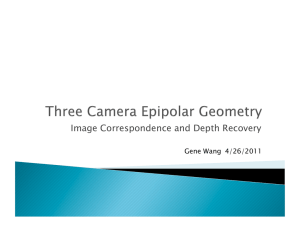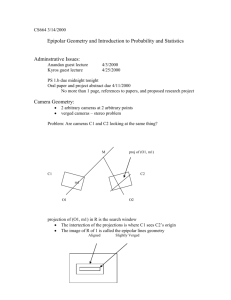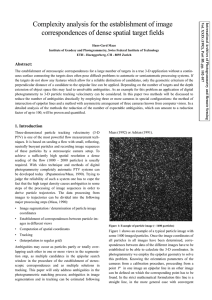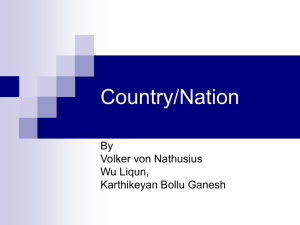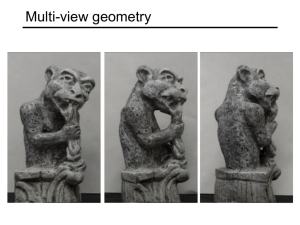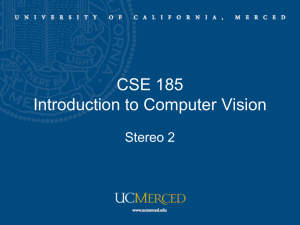Complexity analysis for tlle establishment of image
advertisement
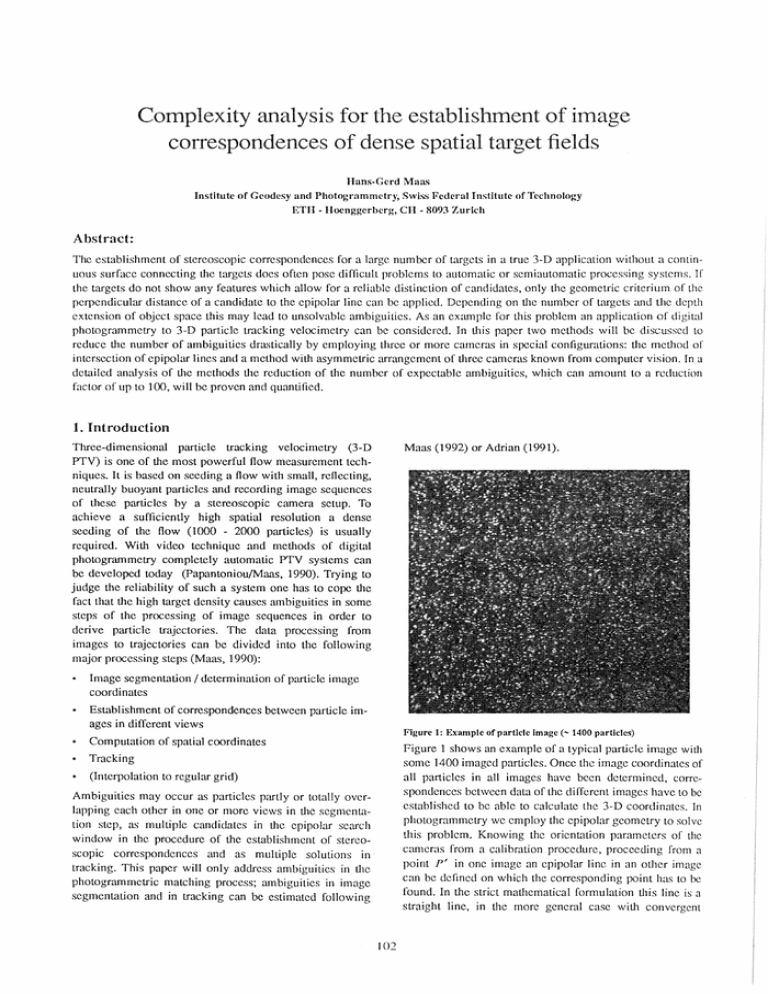
Complexity analysis for tlle establishment of image
correspondences of dense spatial target fields
Hans-Gerd Ma~l'i
Institute of G{\odcsy und Photogrammetry, Swiss Federal Institute of Teclmology
ETH - Hocnggerbcrg, CH - 8093 ZurIch
Abstract:
The establishment of stereoseopic eorrespondenees for a large numbcr of targets in a true 3-D application without a eontinuous surface eonnecting the targets does often pose diffieult problems Lo automatie or semiautomatic processing systems. Ir
thc targets do not show any features whieh allow for a reliable distinetion of candidatcs, only the geometrie criterium of the
pcrpendicular distance of a eandidate to thc epipolar line can be applied. Depending on thc number of targets ana the depth
extension of objeet space this may lead to unsolvable ambiguiLies. As an example for this problem an application of digital
photogrammetry to 3-D particle tracking velocimetry ean be eonsidered. In this paper two methods will be discussed to
reduce the number of ambiguities drastically by employing three or more cameras in special eonfigurations: the method 01'
intersection of epipolar lines amI a method with asymmetrie arrangement of three cameras known from computer vision. In a
detailed analysis of the mcthods the reduction of the number of expectable ambiguities, which can amount lO a rccluetion
factor of up to 100, will be proven and quantified.
1. Introduction
Three-dimensional particle tracking velocimetry (3-D
PTV) is one of the most powerful How measurement techniques. It is based on seeding a How with smaIl, reHecting,
neutrally buoyant particles and fecording image sequences
of these particles by a stereoscopic camera setup. To
aehieve a sufficiently high spatial resolution a dense
seeding o[ the How (1000 - 2000 partic1es) is usually
requircd. With video technique and methods of digital
photogrammetry completcly automatic PTV systems can
be developcd today (Papan ton iou!Maas , 1990). Trying to
judge the reliability of such a system one has to cope the
fact that the high target density causes ambiguities in some
steps o[ the processing of image sequences in order to
derive partic1e trajectories. The data processing [rom
images to trajectories can be divided into the following
major processing steps (Maas, 1990):
Maas (1992) Of Adrian (1991).
Image segmentation I determination of particle image
coordinates
Establishment of corrcspondences between particle images in different views
Figure I: Example ofparticle Image (... 1400 particles)
Computation of spatial coordinates
Figure 1 shows an example of a typical particle image with
some 1400 imaged partic1es. Once the image coordinates of
a11 partie1cs in alt images have been determincd, corrcspondences between data of the different images have to be
established to be able to ealculatc thc 3-D coordinates. In
photogrammctry we employ the epipolar gcometry to solvc
this problem. Knowing thc oriemaLion parameters of the
eameras from a calibration proccdure, procecding from a
point P' in one image an epipolar line in an other image
can be dcfined on which the eorresponding point has to be
found. In the strict mathematical formulation this line is a
straight line, in the more general case with convergent
Tracking
(Interpolation to regular grid)
Ambiguities may oecur as partic1cs partly or totally overlapping eaeh other in one or more views in the segmenlation step, as multiple candidates in the epipolar search
window in the procedure of the establishment of stereoseopic correspondences and as mulLiple solulions in
tracking. This paper will only address ambiguilies in the
photogrammetric matching process; ambiguitics in image
segmentation and in tracking can be estimated following
102
camera-axes, non-negligible lens distortion and multimedia
geometry (object and sensor in media with different refractive indices) the epipolar Hne will be a slightly bended line.
Its Iength I can be restrieted if approximate knowledge
about the depth range in objeet space is available, e.g. the
range of the illuminated test section. Adding a eertain toleranee width e to this epipolar Hne segment (due to data
quality) the seareh area for the eorresponding particle
image beeomes a narrow twodimensional window in image
space.
P a l2
=
(n - 1)·
2 ,/12 , e .
F
(Eq.3)
one receives the expectable number of ambiguities per stereopair
Na
=
2
2· C ' e . b 12 • (Zmax - Zmin)
(n -n) , - - - - - - - - - F . Zmin . Zmax
(Eq.4)
The number of ambiguities grows
.. approximately with the square of the number of particles
• linearly with the length of the epipolar line segment
• linearly with the width of the epipolar seareh window
2. Two-camera arrangement
With the large number of imaged particles a problem of
ambiguities occurs here, as often two or more particles will
be found in the seareh area. If the particle features like size,
shape or color do not allow a reliable distinetion of particles, these ambiguities eannot be solved by a system based
on only two eameras.
With realistie suppositions for the number of particles per
image and the dimensions of the epipolar search window in
a reasonable camera setup the number of ambiguities to be
expected becomes that large (see table 1), that a twocamera-system will not allow for a robust solution of the
eorrespondenee problem, if the number of targets or the
depth range in object spaee cannot be controlled strictly.
Instead algorithms based on three or more eameras rather
than two will be discussed in the following, which allow a
drastical reduction of the expeetable number of ambiguities,
For a quantifieation of the probability of the oeeurence of
ambiguities a point P centered in object spaee shall be
eonsidered: X = b 12 /2, Z = (Zmill + Zmax) /2. Y = 0
(Figure 2, eonsideration in epipolar plane without loss of
generality).
2.1 Intersection of epipolar lines
A eonsequent solution of the problem is the use of a third
camera in a setup as shown in Figure 3 with the aim of
reducing the seareh spaee from aHne plus toleranee to the
intersection of lines plus tolerance.
Figure 2: length of eplpolar search window
With
Figure 3: arrangement of three CCD cameras for the method of
InterseetIon of epipolar Ilnes
X'
X
Z
c
This setup ean be exploited as shown in Figure 4:
=>
X
Xl = Zmax ' Z' X 2
=
X
Z ml1l
. 'Z
(Eq. 1)
the length of the epipolar search window becomes
C'
b 12 · (Zmax - Zmin)
(Eq.2)
Zmin' Zmax
and with the average number of ambiguous particles per
seareh window
Figure 4: princlple of Intersection of eplpolar Iines
103
Proceeding from a point P' in the image 11 all epipolar
lines E 1 ~ 2 in 12 and E 1 ~ 3 in 13 are being derived, on
wh ich candidates Pa", Pb" and P /' resp. P /". P /" and
P/" may be assumed to be found. An unambiguous determination of the partiele image corresponding to p' can
neither be found in 12 nor in 13• However if an epipolar
lines E (2 ~ 3). of an candidates P j in 12 are being intersected with the epipolar Une E 1 ~ 3' there will be a large
probability that only one of the intersection points will be
elose at one of the candidates in 13 (in Figure 4: P /").
This consideration has been implemented via a combinatorics algorithm which tries to find such consistent triplets
in the three datasets and rejects points which are members
of more than one consistent triplet. Such an unambigous
consistent triplet is a necessary and sufficient condition for
the establishment of a correct correspondence. A similar, .
iterative approach can be found in (Kearney, 1991).
1
23
P23 = - - 2· e . /23
the probability Pa(1) of this first kind of ambiguities becomes
(Eq. S)
F· b 23 • sina
2. the epipolar Hne E 2 ~ 3 of a 'wrong' candidatc Q" on
the epipolar Hne EI ~ 2 does also hit the 'correet' candidate P'" on EI ~3 ' because a candidate Q" is
placed too elose at the 'correct' candidate P", or because a too short base component b 13 has been chosen:
This procedure can reduce the probability of ambiguities
drastically, but not totally. The remaining unsolvable, but
detectable ambiguities can be seperated into three cases:
1. a 'wrong' candidate Q" on the epipolar Hnc EI ~ 2 has
got a corresponding partiele image Q'" on E2~3'
which accidently falls onto thc epipolar Hne E 1 ~ 3 :
P'
•
~
~
P'
•
~
4/t 'wrong' candldate
Figure 6: InterseetIon of epipolar lines· second kind of amblgulty
2e
With (Eq. 5), (Eq. 6) the probability for this second kind
of ambiguity is
,....... ........•
P"
Qn
•
________________~___1~1
• "corred' candldate
/~
2e
P"Q"
'oorrec:t' candlclate
.·.·,'I2e,
P a (2)
1
23
= P 12 • ..".---2· e· /
13
4· (n - 1) , e2 , b 12
F·b 13 ,sina
0 'wrong' candida te
Figure 5: IntersectiOil o( epipolar lines • first kind of amblgulty
(Eq.9)
3. A second candidate R'" is found at the intersection of
the epipolar lines EI ~3 and E2~3 of the 'correet'
candidate P'!P" - an event which is often correlated
with the occurence of an overlap:
For a point P centered in object space we get with:
~
12)
(Eq.5)
..;:
Qn.
p.."'.".. ':"''''......... .
.
..
:\:.. 1
13
..
2e
.
P'
""
~
,
..........
P"
and with
(Eq.6)
'"
112
,
.....................
Q"
_________________~h
•
'oorrecl' cllndldate
~
0 'wrong' candidale
Figure 7: Intersection of eplpolar lines· thlrd kind o( amblguity
104
For an possible matches (1-2) a point in object space is
being calculated
The probability for this third kind of ambiguity is
Pa(3)
(n - 1) ./23
=
4· (n - 1) . e2
F
F· sina.
(Eq.10)
c·b 12
Z=--
Px
With (Bq. 8), (Bq. 9) and (Bq. 10) the probability of an
unsolvable ambiguity in the method of intersection of
epipolar lines becomes
Pa
_(4'
2
(n - .1) . e
F· sma
y = O.
(Eq.13)
Depending on an assumed maximum error e of the paralIax
Px the thus established point(s) will have an error mainly in
depth; this leads to a reduced search space 2:3. Z4 in object
= P a (1) +P a (2) +Pa(3)
-
x'
X = Z·c
space:
b 12 b ) ) ,
. ( 1+-+12
b 23
(Eq.11)
b 13
and the expectable number of remaining ambiguities
becomes
N
a
= 4·
2
2
(n _ n) . e
F·sina
b 12 b 12 )
. ( 1+-+b
b
'
23
c.b
(Eq.12)
Z4
C•b
.
Z
12
==- -12- Px + e
c . b +Z . e
12
13
X
An optimum (Le. a minimum number of remaining ambiguities) is achieved with b 12 ::: b 13 ::: b 23 , which means a
configuration of the three projective centers in a equilateral
triangle. Other than in a two camera model the number of
ambiguities does not depend on the 1ength of the epipolar
lines (Le. on the depth range in object space resp. the baselength) any longer. In total the number of ambiguities is
being reduced by at least a factor of 10 (see table 1).
X4
= Z4' -Z
b 13
= Z4' - - - - Zmax+Zmin
(Eq.14)
which is being imaged into image 3, where the length 1123
of the search window becomes
1123
= x'''4- X'''3
2.2 Collinear arrangement of three
cameras
The method of intersection of epipolar lines may be the
most evident, but it is not the only way of exploiting a third
camera. Using a different algorithm one can also work with
three cameras which are arranged in a way that their projective centers are lying on a straight Hne as shown in Figure
8. In this case possible correspondences between the first
and the second image have to be verified by a propagation
into the third image.
(Eq.15)
This way one receives a short epipolar search area in image
3 for alt the candidates in image 2. If exactly one valid
candidate is found in these search spaces the necessary and
sufficient condition for a correct correspondence is
fulfilled.
A similar proceeding is used by Lotz/Fröschle (1990); they
suggest a strongly asymmetric arrangement of cameras as
shown in Figure 9 to reduce the probability of occurence of
ambiguities.
Figure 8: Proceedlng with three comnearly arranged cameras
Figure 9: asymmetrie camera arrangement (LotzIFröschle, 1990)
105
The short base b 12 guarantees for a small number of ambiguities in the establishment of correspondences between
image 1 and 2, while the long base b 13 fuHills the requirement of good depth accuracy. As shown later (Eq. 19 - 23),
this arrangement can minimize the probability of oceurenee
of ambiguities but does not take into consideration that
ambiguities ean be solved; thus it does not represent an
ideal setup if the total number of unsolvable ambiguities is
to be minimized.
and the number of remaining unsolvable ambiguities is
Like the method of interseetion of epipolar lines this
eollinear arrangement has some remaining ambiguities,
which cannot be solved. Two kinds of ambiguities can be
distinguished:
If n, e and b 13 are given by the the number of targets, the
image quality and the requirements of depth ac curacy, the
optimum choiee of b 12 ean be ealeulated; for Pa -7 min
the derivative (ap a) / (ab l2 ) has to be zero:
Pa = Pa(l) +P a (2)
4· (n-1)
F· b l2
·
·e 2 ·bi3
(b 13 - b l2 )
(Eq.18)
,
(Eq.19)
ap
a, !
-=0
ab 12
2
=> 4· (n-1) .e 'b 13
.
'
1
. (
F
__1_) = 0
(b 13 - b l2 ) 2
bi2
=>
(Eq.20)
..............
This shows that the ideal camera arrangement of three
eollinear eameras is a symmetrie arrangement with b12 =
~3 = b 1:Y'2. Like the method of intersection of epipolar
lines the length of the epipolar lines does not have an infiuenee on the number of ambiguities. The efficieney of the
method is almost as good as the method of interseetion of
epipolar lines (see table 1).
••....•
..... .....
'
.......
...:.
2
3
2.3 Comparison of the methods
Flgure 10: length of eplpolar line segments for three·camera-setup
The expectable numbers of remaining ambiguities for the
methods diseussed above ar~ compiled in table 1 for realistie assumptions for the number of partieles (n), the depth
range in object spaee (.1Z) and the width of the epipolar
seareh area (e) for a base b 13 = 200 mm and a camera
eonstant c = 9 mm:
U
1. A point R' is accidently imaged in the seareh area 123
of a 'wrong' eandidate Q" on 112,
With
Table 1: numbers of remaining ambiguities
Number of cameras
arrangement
one receives
2
3
3
col!.
trlang.
........ - ............................................................ -_ ...... -r"'''''''''''''''''''' -_ ............................... .
parameters
(Eq.16)
:
401
40
35
n =2000, e =10 Jlm, IlZ =40 mm
n = 1000, e = 5 Jlm, IlZ =40 mm
:"
:
1605
201
140
:
802
160
10
40
n
2. A second point Q'" is detected in the search area 123 of
the 'correct' eandidate:
:
=1000, e =10 Jlm, IlZ =40 mm
n
=1000, e =10 Jlm, IlZ =80 mm
:
9
35
(Eq.11)
With two eameras the expectable numbers of unsolvable
(hut detectable) ambiguities beeomes that large that the
method itself becomes questionablc. The geometrie
constraint of a third camera leads to a reduetion of the
numbers of ambiguities by at least one order of magnitude.
With (Eq. 17), (Eq. 18) the probability of an unsolvable
ambiguity for this camera arrangement becomes
If the number of remaining ambiguitics is still considered
too large, a further reduetion is possible in a straightforward mann er by employing a fourth camera and either
P a (2)
=
2· (n-l) ·e·[l23
F
4· (n-1) ·e 2 ·b 13
F· b l2
106
arranging the projective centers in a square (-> intersection
of epipolar lines) or on aHne (-> double verification of
possible matches). Such an arrangement will lead to a
reduction factor of at least 100 and almost press the number
of remaining ambiguities against zero. An extension to an
arbitrary number of cameras is also possible but will rarely
be necessary.
•
-+
00
00
)
I,.-
Il
Flgure 12: Example resuUs (0.5 sec. flow data In a stlrred aquarium)
~
~
~
:=p l1it
References:
~
I4
1. Adrian, R., 1991: Particle-Imaging Techniques for Experimantal Fluid Mechanics. Annual Review of Fluid
Mechanics, Vol. 23
J
-
2. Keamey, I.K., 1991: Trinocular Correspondence for
Figure 11: IntersectiOil or eplpolar IInes In a four-camera
arrangement
Particles and Streaks. Dept. of Computer Science, The
University of Iowa, Technical Report 91-01
All the above considerations are only valid for targets
randomly distributed in space without a continuous surface.
Not randomly distributed targets, e.g. regular dot patterns
projected onto a surface lo generate an artificial texture
(Maas, 1991) may lead to no overlapping targets but much
larger numbers of ambiguities, if the pattern is oriented in a
way that it is parallel with the epipolar lines in one or more
images.
3. Lotz, R., Fröschle. E., 1990: 3D-Vision mittels Stereobildauswertung bei Videobildraten. 12. DAGM-Symposium Mustererkennung, Informatik Fachberichte 254,
Springer Verlag
4. Maas, H.-G., 1990: Digital Photogrammetry for Deter-
mination of Tracer Particle Coordinates in Turbulent
Flow Research. ISPRS Com. V Symposium "Close
Range Photogrammetry Meets Machine Vision", 3.-7.
September 1990, Zurich, Switzerland, published in
SPIE Proceedings Series Vol1395, Part 1
3. ResuUs
To test the method it has been applied to simulated datasets
and in several real experiments under various conditions
with good success. In the particle tracking velocimetry
experiments a maximum of about 1000 instantaneous
velocity vectors could be determined with a three camera
setup. To achieve a much higher yield seems to be difficult
with current CCD-sensor resolution mainly due to image
quality and because the number of overlapping particles
becomes loo large. A two camera system could only give
reliable results if the number of particles in the test section
ami the depth range (Le. the thickness of the illuminated
laycr in the water) were strictly controlled. A sampie result
of particle tracking velocimetry with three cameras is
shown in Figure 12
5. Maas, H.-G., 1991: Automated Surface Reconstruction
with Structured Light. Int. Conference on Industrial Vision Metro!ogy, Winnipeg, J uly 11-12, SPIE Proceedings Series Vol. 1526
6. Maas, H.-G., 1992: Complexity analysis for the deter-
mination of dense spatial target fields. 2nd International
Workshop on Robust Computer Vision, March 9-12,
Bonn, Germany
7. Papantoniou, D., Maas, H.-G., 1990: Reccnt Advances
in 3-D Particle Tracking Velocimctry. Proceedings 5th
International Symposium on the Application of Laser
Techniques in Fluid Mechanics, Lisbon, July 9-12
107
